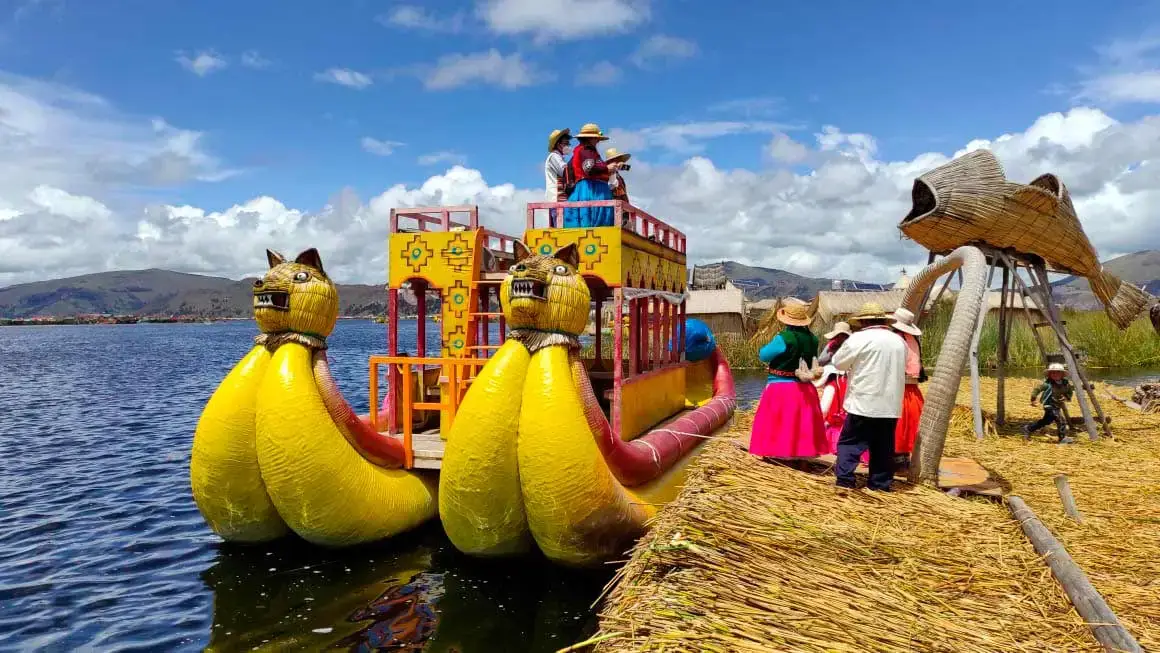At an altitude of 12,500 feet (3,810 meters) in the Andean highlands, Lake Titicaca is renowned as the highest navigable lake on the planet. Stretching across the border between Peru and Bolivia, this massive freshwater lake covers over 3,200 square miles, making it the largest lake in South America. With crystal blue waters contrasted by arid, rolling hills, Lake Titicaca provides a uniquely breathtaking landscape rich in history and culture.
- A Sparkling Lake Straddling Two Countries
- Historic Sites Dotting Ancient Shores
- Myriad Adventure Awaits
- FAQs
- Where is Lake Titicaca located?
- How large is Lake Titicaca?
- What is the significance of Lake Titicaca?
- What are the main attractions around Lake Titicaca?
- How can I explore Lake Titicaca?
- What is the best time to visit Lake Titicaca?
- What is the weather like at Lake Titicaca?
- Are there any altitude considerations for visiting Lake Titicaca?
- Can I visit both the Peruvian and Bolivian sides of Lake Titicaca?
- What should I know about the local culture and customs?
- Book Now

A Sparkling Lake Straddling Two Countries
The majority of Lake Titicaca resides within Peruvian borders, accounting for 56% of the total surface area. The remaining smaller portion crosses the border northeast into Bolivia around smaller cities like Copacabana. Over twenty rivers and streams feed meltwater from nearby mountaintops into Lake Titicaca, though no rivers flow outward. With no outlet, water leaves mainly through evaporation resulting in higher salinity compared to other major lakes.
Historic Sites Dotting Ancient Shores
Besides the spectacular high elevation scenery, Lake Titicaca lures visitors with fascinating glimpses into ancient civilizations. The Uros people construct entire floating islands from dried totora reeds, allowing families to live directly on the water. Stone terraces on Isla del Sol mark one of the speculated sites where Incan origin legends began. And the towering ruins of Tiahuanaco date back to 500 AD, where visitors can glimpse sites that likely inspired nearby Incan structures.

Myriad Adventure Awaits
From sightseeing to adventure, Lake Titicaca offers endless intrigue and excitement no matter your travel style. Hike little-explored Incan trails along the Collao Peninsula. Take a boat to the floating Uros Islands woven ingeniously from reeds. Scuba dive to explore underwater ruins and unique wildlife. Or simply relax on a hillside terrace to watch the sunset over breathtaking high-altitude waters. Lake Titicaca promises majestic scenery blended seamlessly with vibrant cultural tradition.

FAQs
Where is Lake Titicaca located?
Lake Titicaca is situated in the Andes Mountains on the border between Peru and Bolivia in South America.
How large is Lake Titicaca?
Lake Titicaca is one of the largest lakes in South America and is the highest navigable lake in the world. It covers an area of approximately 8,372 square kilometers (3,232 square miles).
What is the significance of Lake Titicaca?
Lake Titicaca holds great cultural and historical significance. It is believed to be the birthplace of the Inca civilization, and numerous archaeological sites and ruins can be found in the surrounding area.
What are the main attractions around Lake Titicaca?
Popular attractions include the Uros Floating Islands, Taquile Island, Amantani Island, and the Inca ruins of Sillustani. Visitors can also experience traditional Andean culture, including colorful festivals and local markets.
How can I explore Lake Titicaca?
Travelers can take boat tours to visit the various islands on the lake, stay with local families for an authentic cultural experience, or hike along the scenic trails surrounding the lake.
What is the best time to visit Lake Titicaca?
The best time to visit Lake Titicaca is generally considered to be the dry season, from May to October, as the weather is cooler and there is less chance of rain. However, you can visit the lake year-round.
What is the weather like at Lake Titicaca?
The weather at Lake Titicaca can vary depending on the season and altitude. Days are typically mild with cool nights. It’s advisable to bring layers and be prepared for changes in temperature.
Are there any altitude considerations for visiting Lake Titicaca?
Lake Titicaca is located at a high altitude, with some areas reaching over 3,800 meters (12,500 feet) above sea level. Visitors should take precautions to acclimatize to the altitude, such as staying hydrated and avoiding strenuous activity upon arrival.
Can I visit both the Peruvian and Bolivian sides of Lake Titicaca?
Yes, it is possible to visit both the Peruvian and Bolivian sides of Lake Titicaca. Travelers may need to arrange for appropriate visas and permits depending on their nationality and travel plans.
What should I know about the local culture and customs?
Respect for local customs and traditions is important when visiting Lake Titicaca. Visitors should be mindful of cultural sensitivities, ask for permission before taking photographs of locals, and support the local economy by purchasing handmade crafts and souvenirs.

